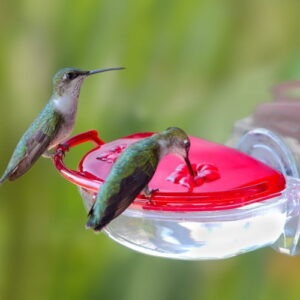Can you hear it? That low buzz in the air can 
only mean one thing: The hummingbirds are coming. Yes, with spring finally here and the cold behind us (hopefully), migrating birds have slowly been making their way back to northern regions, including the beloved hummingbird.
Even though late winter storms have delayed the arrival of hummingbirds in some areas, it doesn’t mean you shouldn’t be prepared for these small birds. Here’s what you need to know about your hummingbird feeders.
How often should you change nectar and clean the feeder?
The big question you’ll run into throughout spring is how often you should change hummingbird nectar and completely clean the feeder. The simple answer to that is at least every three days, but it really depends on the temperature outside. Nectar goes bad much quicker when the temperatures are high and you don’t want to risk exposing your hummingbirds to bacteria.
Here’s a useful chart from howtoenjoyhummingbirds.com on when you should change your feeder in different temperatures:
High temperatures…………Change nectar after
71-75……………………………6 days
76-80……………………………5 days
81-84……………………………4 days
85-88……………………………3 days
89-92……………………………2 days
93+………………………………change daily
You can also do a quick sight test to see if there’s any discoloration or visible slime. If that’s the case, then you want to clean the feeder as soon as possible. Generally, it’s wise to be as safe as possible when it comes to hummingbird feeders because you don’t want any mold to start growing and cause harm.
How to clean your hummingbird feeder
We’ve covered cleaning bird feeders pretty extensively on the site, but it can be slightly different with hummingbird feeders. Start off by taking down the feeder and dumping out any nectar that might be leftover. Since hummingbird nectar is so easy to make, there’s no reason to reuse it.
Next, take apart the feeder by disassembling all the pieces. Rinse them with warm water and soak the pieces in a cleaning solution, like the Care Free Enzyme Hummingbird Cleaner. Use a brush to thoroughly clean every crevice, including the inside of the feeder where the nectar goes.
Then you should completely rinse off the cleaning solution, so no soap or residue remains. Allow all the pieces to sit and reassemble the feeder once everything is dry.
It’s really as simple as that. It can be annoying having to clean your feeders so often, but it’s for the health of your backyard friends.
Here’s a great how-to video if you’re a visual person.



2 Comments
So excited – ours made their first appearance on Easter Day. S. Ga is so hot, I now buy two of every kind that I put up. One set goes out, one in the fridge. Then I always have a fresh one to put out so they don’t “dive bomb” me like they used to!